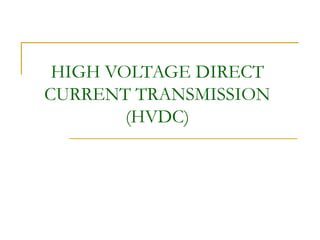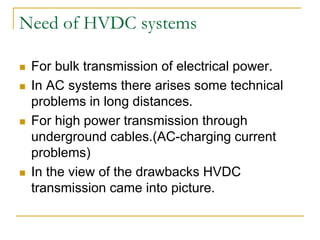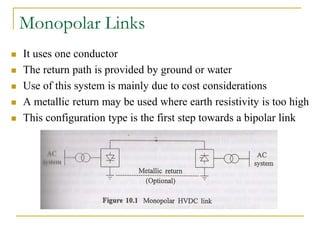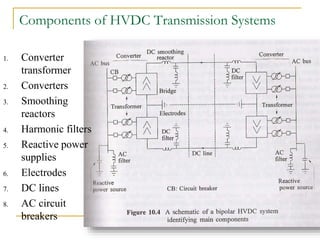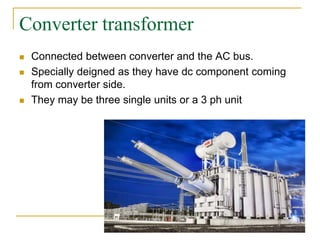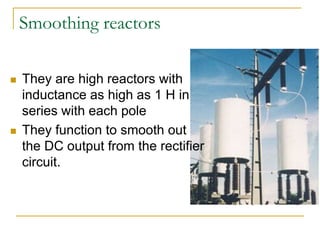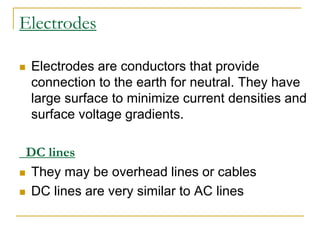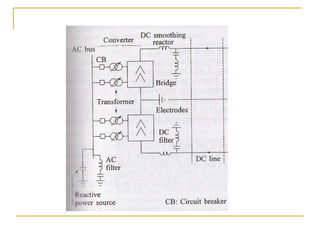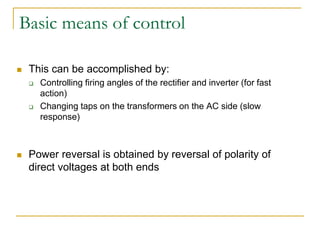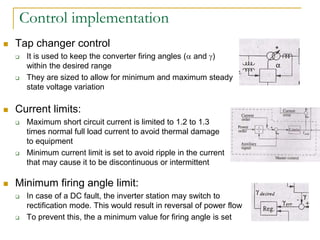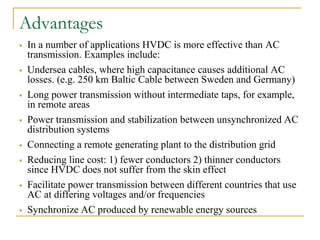Hvdc
- 1. HIGH VOLTAGE DIRECT CURRENT TRANSMISSION (HVDC)
- 2. History First commercial application of HVDC between Swedish mainland and the island of Gotland in 1954. Underwater link of 90 km and 20 MW. With reduced size, cost and improved reliability of power electronic converters, has made HVDC transmission more widespread.
- 3. Need of HVDC systems For bulk transmission of electrical power. In AC systems there arises some technical problems in long distances. For high power transmission through underground cables.(AC-charging current problems) In the view of the drawbacks HVDC transmission came into picture.
- 5. HVDC System Configurations and Components HVDC links can be broadly classified into: Monopolar links Bipolar links Homopolar links Multiterminal links Back-to-back links
- 6. Monopolar Links It uses one conductor The return path is provided by ground or water Use of this system is mainly due to cost considerations A metallic return may be used where earth resistivity is too high This configuration type is the first step towards a bipolar link
- 7. Bipolar Links It uses two conductors, one positive and the other negative. Each terminal has two converters of equal rated voltage, connected in series on the DC side The junctions between the converters is grounded Currents in the two poles are equal and there is no ground current If one pole is isolated due to fault, the other pole can operate with ground and carry half the rated load.
- 8. Homopolar Links It has two or more conductors all having the same polarity, usually negative Since the corona effect in DC transmission lines is less for negative polarity, homopolar link is usually operated with negative polarity The return path for such a system is through ground
- 9. Multiterminal links Transmits power between three or more AC substation. Frequency conversion is possible. In Europe where there is international grid, power can be exchanged between nations.
- 10. Back-to-back links For frequency conversion. For asynchronous interconnection. Both Rectifier & Inverter are at same place, connected in DC loop. There is no DC transmission line.
- 11. Components of HVDC Transmission Systems 1. Converter transformer 2. Converters 3. Smoothing reactors 4. Harmonic filters 5. Reactive power supplies 6. Electrodes 7. DC lines 8. AC circuit breakers
- 12. Converter transformer Connected between converter and the AC bus. Specially deigned as they have dc component coming from converter side. They may be three single units or a 3 ph unit
- 13. Converters They perform AC/DC and DC/AC conversion. They consist of thyristor bridges and transformers. Thyristor bridge consists of high voltage thyristor connected in a 6-pulse or 12-pulse arrangement. The transformers are ungrounded such that the DC system will be able to establish its own reference to ground.
- 14. Smoothing reactors They are high reactors with inductance as high as 1 H in series with each pole They function to smooth out the DC output from the rectifier circuit.
- 15. Harmonic filters Converters generate harmonics in voltages and currents. These harmonics may cause overheating of capacitors and interference with telecommunication systems Harmonic filters are used to mitigate these harmonics twelve-pulse bridge converter is used because it creates harmonics of order 12n+1 on AC side and 12n on DC side
- 16. Reactive power supplies Under steady state condition conditions, the reactive power consumed by the converter is about 50% of the active power transferred Under transient conditions it could be much higher Reactive power is, therefore, provided near the converters For a strong AC power system, this reactive power is provided by a shunt capacitor
- 17. Electrodes Electrodes are conductors that provide connection to the earth for neutral. They have large surface to minimize current densities and surface voltage gradients. DC lines They may be overhead lines or cables DC lines are very similar to AC lines
- 18. AC circuit breakers They used to clear faults in the transformer and for taking the DC link out of service They are not used for clearing DC faults DC faults are cleared by converter control more rapidly
- 20. Multiple Bridge Converters Two or more bridges are connected in series to obtain as a high a direct voltage as required These bridges are series on the DC side, parallel on the AC side A bank of transformers is connected between the AC source and the bridges The ratio of the transformers are adjustable under load Multiple bridge converters are used in even numbers and arranged in pairs for 12-pulse arrangement
- 21. Multiple Bridge Converters Two banks of transformers, one connected in Y-Y and the other Y- are used to supply each pair of bridges The three-phase voltage supplied at one bridge is displaced from the other by 30 degrees These AC wave shapes for the two bridges add up to produce a wave shape that is more sinusoidal than the current waves of each of the 6-pulse bridges This 12-pulse arrangement effectively eliminates 5th and 7th harmonics on the AC side. This reduces the cost of harmonic filters This arrangement also reduces ripple in the DC voltage
- 23. Basic means of control This can be accomplished by: Controlling firing angles of the rectifier and inverter (for fast action) Changing taps on the transformers on the AC side (slow response) Power reversal is obtained by reversal of polarity of direct voltages at both ends
- 24. Control implementation Tap changer control It is used to keep the converter firing angles ( and ) within the desired range They are sized to allow for minimum and maximum steady state voltage variation Current limits: Maximum short circuit current is limited to 1.2 to 1.3 times normal full load current to avoid thermal damage to equipment Minimum current limit is set to avoid ripple in the current that may cause it to be discontinuous or intermittent Minimum firing angle limit: In case of a DC fault, the inverter station may switch to rectification mode. This would result in reversal of power flow To prevent this, the a minimum value for firing angle is set
- 25. Advantages In a number of applications HVDC is more effective than AC transmission. Examples include: Undersea cables, where high capacitance causes additional AC losses. (e.g. 250 km Baltic Cable between Sweden and Germany) Long power transmission without intermediate taps, for example, in remote areas Power transmission and stabilization between unsynchronized AC distribution systems Connecting a remote generating plant to the distribution grid Reducing line cost: 1) fewer conductors 2) thinner conductors since HVDC does not suffer from the skin effect Facilitate power transmission between different countries that use AC at differing voltages and/or frequencies Synchronize AC produced by renewable energy sources
- 26. Disadvantages The disadvantages of HVDC are in conversion, switching and control. Expensive inverters with limited overload capacity Higher losses in static inverters at smaller transmission distances The cost of the inverters may not be offset by reductions in line construction cost and lower line loss. High voltage DC circuit breakers are difficult to build because some mechanism must be included in the circuit breaker to force current to zero, otherwise arcing and contact wear would be too great to allow reliable switching.
